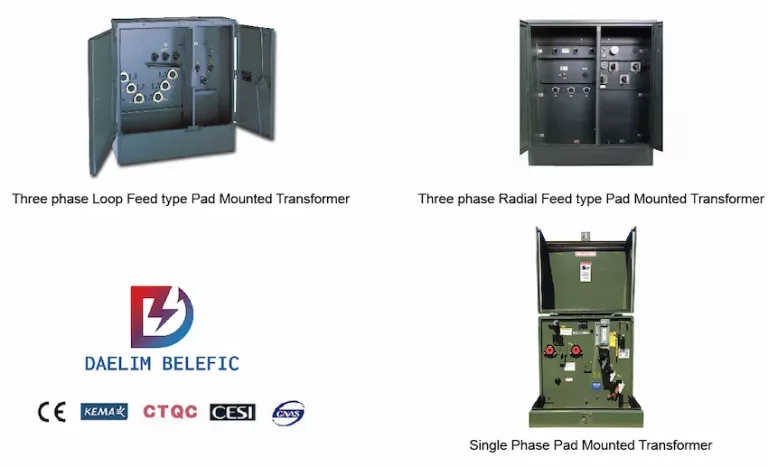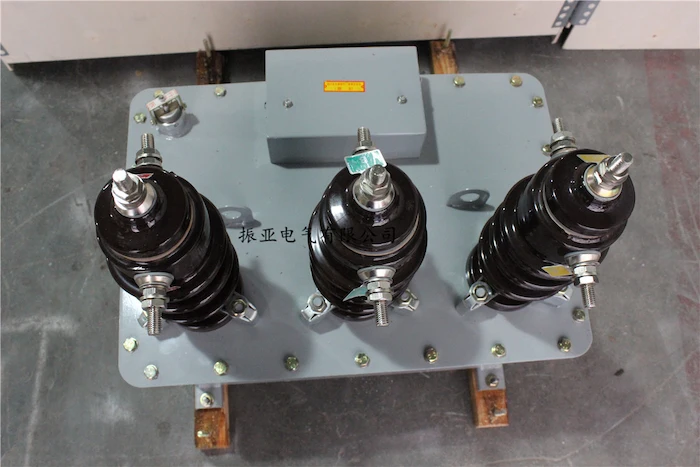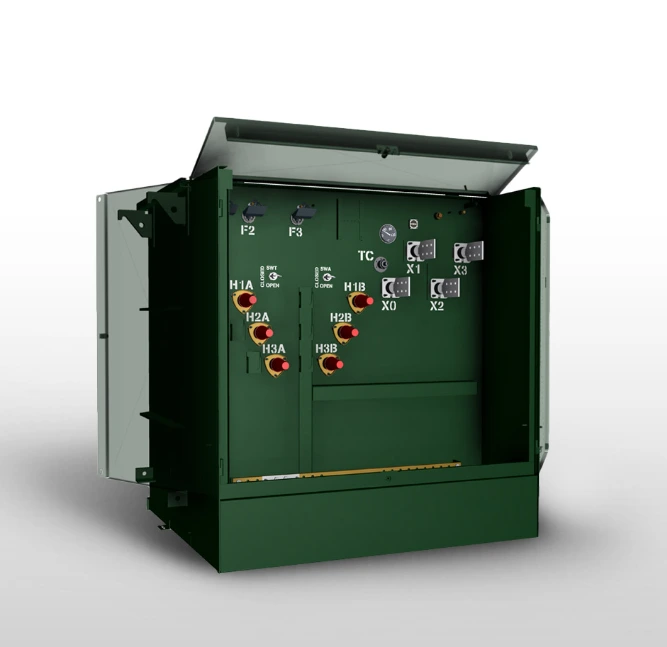ELECTRIC, WITH AN EDGE
The three-phase overload transformer is composed of a three-phase transformer and a heat sink connected to the transformer at the front and rear ends of the transformer.
The design of the three-phase overload transformer needs to take into account specific conditions such as the ability to withstand short circuits, the overload capacity, and the temperature rise limit in the product performance. It reflects the characteristics of the transformer product with high overload capacity.
A distribution transformer is a kind of isolation transformer.
The main use of this transformer is to alter voltages from high to low, like 240/120 V, to use in electric power distribution.
There are different types of transformers in the distribution system, such as single-phase, three-phase, underground, pad-mounted, and pole-mounted transformers.
Three-Winding Transformer | Three-Phase Transformer | Daelim

Looking for a reliable and trustworthy manufacturer of high-quality 3 phase overhead transformers? Look no further than Daelim Belefic!
With over 15 years of experience in the industry, we specialize in the design, engineering, and production of top-of-the-line electrical equipment. Our 3 phase overhead transformers are built to the highest standards, ensuring superior performance, reliability, and longevity.
At Daelim Belefic, we’re committed to providing our customers with the best possible service. Our “DAELIM EDGE + ADVANTAGE” concept allows us to offer multiple standards, professional customization, and cutting-edge solutions, all delivered with speed and efficiency.
We pride ourselves on our investment in research and development, which allows us to provide efficient and innovative product solutions that help our customers reduce costs and create new value. Our team of experts has over 20 years of transformer design experience and is familiar with international transformer standards such as IEC, IEEE/ANSI, CSA, and more. We use the latest technology, machines, and facilities to produce our transformers, while ensuring that our products are made of qualified standard materials procured from world-renowned suppliers.
At Daelim Belefic, quality is one of our core values. We strictly implement the ISO 9001 quality management system and conduct three different quality tests (Type Test, FAT Test, and Inspection Test) to ensure that our transformers meet the highest standards of reliability and safety.
Our team is full of experts and professionals who are committed to meeting our customers’ needs and providing exceptional service. We are dedicated to continuous improvement and strive to be a trusted and valued partner in the global electric industry.
Choose Daelim Belefic for your 3 phase overhead transformer needs and experience the difference of working with a reliable and reputable manufacturer. Contact us today to learn more about our products and services!
The most common kind of distribution transformer used is the single-phase oil-filled, pole-mounted transformer.
They are normally referred to as a “pole-top” or “overhead” transformer. Overhead transformers differ in their physical size and how they connect to produce different secondary voltage outputs.

The functions of a three-phase system, like a standard three-phase system, are to generate and distribute electricity.
It generates power on a larger scale to meet the demands of industries and commercial establishments.
These transformers are used to change voltages of electrical systems with three phases.
The three types of configurations are star-star, delta-delta, star-delta, and delta-star.
Technically, three-phase overhead transformers are just overhead transformers with a three-phase system.
The only key differences of a three-phase overhead transformer from a standard three-phase system include sizes/rating, mounting locations, and applications.
Standard three-phase overhead transformer sizes are 3, 6, 9, 15, 30, 45, 75, 150, 225, 300, 500, 750, and 1,000 (kVA)
To get the specific sizes, it is better to consult your supplier.
In addition, be careful not to mention specific patents, products, and brand names not tied to the client’s company (Daelim).
A 3-phase overhead transformer is an electrical device that is designed to convert high-voltage electricity, typically carried on power lines, into a lower voltage suitable for use in homes and businesses. It is called “3-phase” because it has three conductors or wires that carry alternating current, each 120 degrees out of phase with each other. These transformers are mounted on utility poles, hence the name “overhead transformer.” They are used to distribute power to homes, businesses, and other locations within a specific area. They play a critical role in the electrical grid by helping to step down the voltage and ensuring that electricity is delivered safely and efficiently.
Three Phase Epoxy-resin Dry Type Distribution Transformer Manufacturer – Daelim
In a single-phase power system, power lines are the input source.
But there is only a single primary and one secondary winding required to achieve the voltage transformation.
The single-phase transformer uses these two windings to transform the voltage.
A single-phase transformer has various models that differ in horsepower range, taps, mounting types, dimensions, kVA, and shipping weight.

Three-phase powers work differently because they are generated by rotating three windings or coils through a magnetic field within a generator.
The three windings are apart by 120 degrees.
They generate power as they rotate through the magnetic field. The generated power is sent out on three different lines, hence the term “three-phase” power.
Standard single-phase overhead transformer sizes are: 5, 10, 15, 25, 37.5, 50, 75, 100, and 167 (kVA).
Common electrical ratings of a single-phase power:
Are you looking to purchase a three-phase transformer? If you are, then you should know about the advantages and disadvantages of three-phase transformers.
3 phase overhead transformers have several advantages that make them a popular choice for power distribution. Some of the benefits of using 3 phase overhead transformers include:
Efficient Power Transmission: 3 phase overhead transformers are highly efficient and can transmit large amounts of power over long distances without significant power loss. This makes them ideal for supplying power to remote areas.
Cost-Effective: Compared to underground transformers, 3 phase overhead transformers are more cost-effective to install and maintain. They require fewer materials and labor during installation, and their maintenance costs are lower.
Easy to Install and Maintain: 3 phase overhead transformers are designed to be mounted on poles, which makes installation and maintenance easy. This means that the transformers can be quickly and easily replaced or repaired in case of a fault.
Durability: Overhead transformers are built to withstand harsh weather conditions and extreme temperatures. They are designed to be corrosion-resistant and can last for several decades with proper maintenance.
Reliable: 3 phase overhead transformers have a high level of reliability, which means they can deliver consistent and stable power supply to the consumers. They are designed to withstand short circuits and other electrical disturbances, and can quickly isolate any fault.
Flexibility: 3 phase overhead transformers can be easily relocated in case of changes in power demand or infrastructure development. They can be easily moved to new locations, which makes them a flexible and adaptable solution for power distribution.
Overall, 3 phase overhead transformers offer a cost-effective, reliable, and durable solution for power distribution, making them a popular choice for utilities and industrial applications.
When it comes to purchasing a transformer, it is important to know everything about it.
The three-phase transformer is no exception. Here are some of the disadvantages of three-phase transformers so you can be informed.
Sizing your transformers is simple. It uses a straightforward formula to generate your kVA requirements from the current and voltage of your electrical load.
Most kVA ratings are whole numbers, and most of them come in multiples of five or 10 to 15, 150, 1,000 kVA, and so on.
If your transformer is rated at 1.5 kVA and you want it operated at 25 volts, multiply 1.5 by 1,000 to get 1,500 and divide 1,500 by 25 to get 60.
Analysis of Performance Data of High Voltage Distribution Transformer
The top line of the utility pole is the static wire.
The static wire is like a lightning conductor, breaking off any excess charges from the power lines when lightning strikes during a thunderstorm.
This wire is connected to the grounding conductor.

Primary and secondary lines are located under the MGN.
The primary line carries electricity to a substation at 5 to 30 kV. Being supported by crossbars on older types of utility poles.
The secondary line is also named the secondary service drop.
The service drop leads from utility pole lines to a house. It consists of three-conductor wires.
Two of them are insulated wires carrying electricity from the transformer.
The third one is a bare neutral wire connecting to the grounding wire.
These lines have voltages of 120 to 240 volts.
What are the main neutral grounding methods of power systems?
Below the static line, there are three power lines known as the transmission lines.
Transmission lines are typically labeled as “A,” “B,” and “C”.
They can conduct high voltage electricity from a power plant to a substation.
A substation decreases the amount of voltage from 69 to 500 kVdown to five to 30 kV.
Power is then sent out on feeder lines connected to buildings and homes.
In most suburban neighborhoods, the distribution lines are underground.
There are green transformer boxes at every house or two.
Two wires run out of the transformer, and three wires run to the house.
The two from the transformer are insulated. Meanwhile, the third one is bare.
Bare wires are the ground wires. These two insulated wires each carry 120 volts.
DAELIM’s professional advice is to get the best-quality three-phase distribution transformers for safety purposes, lesser maintenance, longevity, and overall acquire the best value out of you or your company’s money
This is why DAELIM, one of the top companies in the world specializing in three-phase distribution transformers, will provide and share with you their 15 years of expertise to be knowledgeable of three-phase distribution transformers, pole-mounted transformer locations, and pole-mounted transformer specifications. Contact them today to learn more.
The key features of a 3 phase overhead transformer include:
Primary and secondary windings: The transformer has primary and secondary windings that convert high voltage electricity into lower voltage electricity suitable for distribution to homes and businesses.
Three-phase system: A 3 phase overhead transformer is designed to work with a three-phase system, which allows for the transmission of larger amounts of power over longer distances with less energy loss.
High voltage capacity: The transformer has a high voltage capacity that can range from 2.4 kV to 34.5 kV or more, depending on the application.
Overhead design: The transformer is designed to be mounted on poles or other overhead structures, allowing for easy installation and maintenance.
Robust construction: A 3 phase overhead transformer is built to withstand harsh outdoor environments, with features such as weather-resistant enclosures, cooling systems, and protective coatings.
Efficient operation: The transformer is designed to operate with high efficiency, reducing energy losses and minimizing the environmental impact.
Multiple sizes and configurations: 3 phase overhead transformers are available in various sizes and configurations to meet the needs of different applications, from residential to industrial.
Cost-effective: 3 phase overhead transformers are generally more cost-effective than underground transformers, as they require less infrastructure and installation costs.
Safety features: The transformer is designed with safety features such as protective fuses and circuit breakers to prevent damage and ensure safe operation.
Overall, the key features of a 3 phase overhead transformer make it a reliable and efficient option for power distribution in various settings.

3-phase pole mounted transformers come in a variety of sizes and capacities to meet the different power requirements of customers. The most common 3-phase pole mounted transformer sizes include 25 kVA, 37.5 kVA, 50 kVA, 75 kVA, 100 kVA, 167 kVA, 250 kVA, and 333 kVA.
The selection of the appropriate size of the 3-phase pole mounted transformer depends on the electrical load requirements of the customers, as well as other factors such as the length of the distribution lines, distance between the transformer and the load, and power factor correction requirements. A qualified engineer can help determine the best size of the 3-phase pole mounted transformer for a specific application.
It is important to note that the size of the transformer has a direct impact on its price, with larger transformers being more expensive than smaller ones. However, selecting the appropriate size of the transformer ensures efficient and reliable operation, while also minimizing energy losses and reducing the total cost of ownership over the transformer’s life cycle.
The price range of 3 phase overhead transformers can vary widely depending on various factors, such as the power rating, voltage level, insulation material, and brand. Typically, smaller transformers with a lower power rating can cost a few thousand dollars, while larger transformers with higher power ratings can cost tens of thousands of dollars or more.
Other factors that can affect the price of a 3 phase transformer include the design, construction materials, and the level of customization required. Some manufacturers may offer standard models with fixed specifications, while others may provide customized solutions to meet specific customer requirements, which can add to the overall cost.
It’s important to note that while the initial cost of a transformer may seem high, it’s a long-term investment in the reliability and efficiency of an electrical system. Choosing a high-quality 3 phase overhead transformer from a reputable manufacturer can help to minimize maintenance costs and ensure optimal performance over the transformer’s lifetime.
Three-phase pole-mounted transformers are available in various sizes and configurations to meet the power requirements of different applications. Some of the common 3 phase pole mounted transformer sizes include:
5 kVA
10 kVA
15 kVA
25 kVA
37.5 kVA
50 kVA
75 kVA
100 kVA
167 kVA
The appropriate size of a 3 phase pole mounted transformer for a specific application depends on the power requirements of the system. The size of the transformer determines the amount of power that can be delivered to the load, and it is important to choose the right size to ensure that the system operates efficiently and reliably.
The common three-phase overload transformers on the market are mainly oil-immersed transformers. The limitation of specific values can be involved according to your requirements.
Daelim has a professional transformer design and production team. They have gone through more than fifteen years of work and can perfectly fulfill your needs.
Download Resource
After filling in the contact information, you can download the PDF.